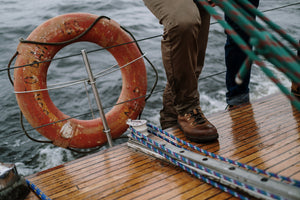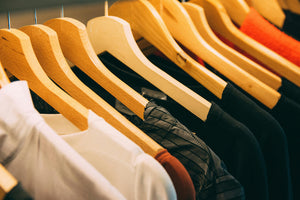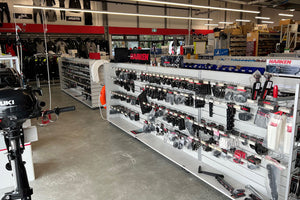
Essential Boat Safety Equipment Checklist: A Guide for Boat Owners
As we embrace the crisp air of autumn, there’s no better time to review essential boat safety equipment. Whether you're embarking on a day trip, a weekend adventure or competing in a regatta, maintaining the highest safety standards is crucial for both enjoyment and peace of mind. A comprehensive boat safety equipment checklist is the foundation for a safe and successful outing, ensuring you're prepared for anything that might arise on the water.
1. Essential Safety Gear
Before setting sail, ensure you have the right safety gear on board. This includes all the tools needed to protect yourself and your crew. The basics are simple but vital:
-
Lifejackets: These are non-negotiable. Ensure every person on board has a life jacket that fits properly, especially for children or those less experienced in the water.
-
Flares and Signal Devices: In case of emergency, visible distress signals are essential. Keep a flare kit or other visual distress signalling devices readily accessible.
-
Fire Extinguisher: It’s easy to forget, but the risk of fire aboard a boat is real, particularly near fuel tanks. Always have an approved fire extinguisher on hand.
2. Life-saving Equipment
Life-saving equipment doesn’t stop at lifejackets. As part of your boat safety equipment checklist, consider adding:
-
Throwable Devices: Life rings, cushions, or buoys are crucial if someone falls overboard. These devices can quickly assist in pulling them back to safety.
-
First Aid Kit: Keep a comprehensive first aid kit stocked with supplies to handle minor injuries or more serious emergencies. Consider including marine-specific items like seasickness tablets.
3. Compliance Essentials
In New Zealand, as well as globally, boat safety regulations are strict. Ensuring your boat safety equipment checklist is compliant with local maritime laws is essential. This not only keeps you safe but also ensures you avoid fines or penalties:
-
Registration and Identification: All boats must display registration numbers and have the required documentation, including insurance and ownership papers.
-
Marine Radio: In certain areas, carrying a marine radio for communication is required. This tool is invaluable during emergencies or for staying in contact with harbour authorities.
4. Maintenance Tips
As the autumn season beckons, it’s an excellent time for boat owners to carry out routine maintenance. A boat's safety equipment requires consistent checks to ensure reliability. Here are a few tips:
-
Inspect Lifejackets and PFDs: Over time, lifejackets and personal flotation devices (PFDs) can degrade, losing their buoyancy or becoming damaged. Check that all equipment is intact, including the zippers, straps, and reflectors.
-
Replace Expired Flares: Flares have an expiration date, and you don’t want to rely on outdated equipment in an emergency.
-
Check Fire Extinguishers: Fire extinguishers need to be serviced and pressure tested regularly to remain effective.
5. Racing Regulations
For competitive sailors, staying compliant with racing regulations is paramount. The boat safety equipment checklist for race day differs slightly from recreational boating. Ensure your boat is outfitted with:
-
Redundant Safety Gear: Many regatta organisers require additional safety measures, such as backup lifejackets, lights, and even a secondary fire extinguisher.
-
Wind Indicator and Compass: Accurate navigational tools such as a Wind Indicator and Compass are essential for performance and safety, particularly in races where precision counts.
6. Luxury Boat Must-Haves
For luxury boat owners, safety is no less important, but your boat safety equipment will include some premium additions too. This can include:
-
Customised Life-saving Devices: For luxury vessels, consider life vests that are not only functional but also stylish and comfortable.
-
Advanced Navigation Systems: Cutting-edge GPS systems, sonar devices, and radar are invaluable for navigating open waters safely.
-
Upgraded Fire Suppression Systems: Larger boats often have more advanced fire suppression systems, which are crucial for preventing damage in the event of a fire.
7. Professional Inspections
For any boat—whether luxury, classic, or race-ready—professional inspections are critical. While some safety equipment can be checked by the owner, others require a qualified marine surveyor to ensure everything is up to standard. Regular inspections help prevent costly repairs and confirm your equipment is functioning correctly.

In addition to professional inspections, it's crucial for boat owners to take an active role in maintaining their vessels. This means developing a keen eye for detail and a proactive approach to boat care. Regularly inspecting your boat's systems, from the engine and electrical components to the rigging and deck hardware, can help you spot potential issues before they become serious problems. Your boat will thank you for it, and you'll be able to enjoy the freedom of sailing with peace of mind.
As the autumn season settles in, there’s no better time to assess your boat safety equipment checklist and ensure your vessel is ready for whatever adventures lie ahead. From the basics like life jackets and flares to more specialised gear for luxury and bigger boats, having the right equipment on board is essential for safe and enjoyable sailing. Regular maintenance checks and professional inspections are key to ensuring your safety gear remains reliable and effective.
---
For more insights and product recommendations, visit the Fosters’ official website and explore how our gear can help you sail smarter, safer, and faster.



